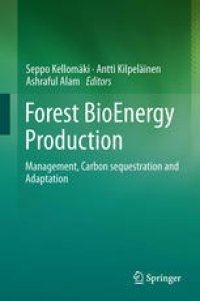
Ebook: Forest BioEnergy Production: Management, Carbon sequestration and Adaptation
- Tags: Plant Breeding/Biotechnology, Forestry Management, Energy Policy Economics and Management
- Year: 2013
- Publisher: Springer-Verlag New York
- Edition: 1
- Language: English
- pdf
For thousands of years, forest biomass or wood has been among the main energy sources of humans around the world. Since the industrial revolution, fossil fuels have replaced wood and become the dominant source of energy. The use of fossil fuels has the disadvantage of increasing atmospheric concentrations of greenhouse gases (GHGs), especially carbon dioxide (CO2), with the consequent warming of global climate and changes in precipitation. In this context, the substitution of fossil fuels with renewable energy sources like forest biomass is among the ways to mitigate climate change.
This book summarizes recent experiences on how to manage forest land to produce woody biomass for energy use and what are the potentials to mitigate climate change by substituting fossil fuels in energy production. In this context, the book addresses how management can affect the supply of energy biomass using short-rotation forestry and the conventional forestry applying long rotations. Furthermore, the book outlines the close interaction between the ecological systems and industrial systems, which controls the carbon cycle between the atmosphere and biosphere. In this context, sustainable forest management is a key to understand and control indirect carbon emissions due to the utilization of forest biomass (e.g. from management, harvesting and logistics, and ecosystem processes), which are often omitted in assessing the carbon neutrality of energy systems based on forest biomass. The focus in this book is on forests and forestry in the boreal and temperate zones, particularly in Northern Europe, where the woody biomass is widely used in the energy industry for producing energy.
For thousands of years, forest biomass or wood has been among the main energy sources of humans around the world. Since the industrial revolution, fossil fuels have replaced wood and become the dominant source of energy. The use of fossil fuels has the disadvantage of increasing atmospheric concentrations of greenhouse gases (GHGs), especially carbon dioxide (CO2), with the consequent warming of global climate and changes in precipitation. In this context, the substitution of fossil fuels with renewable energy sources like forest biomass is among the ways to mitigate climate change.
This book summarizes recent experiences on how to manage forest land to produce woody biomass for energy use and what are the potentials to mitigate climate change by substituting fossil fuels in energy production. In this context, the book addresses how management can affect the supply of energy biomass using short-rotation forestry and the conventional forestry applying long rotations. Furthermore, the book outlines the close interaction between the ecological systems and industrial systems, which controls the carbon cycle between the atmosphere and biosphere. In this context, sustainable forest management is a key to understand and control indirect carbon emissions due to the utilization of forest biomass (e.g. from management, harvesting and logistics, and ecosystem processes), which are often omitted in assessing the carbon neutrality of energy systems based on forest biomass. The focus in this book is on forests and forestry in the boreal and temperate zones, particularly in Northern Europe, where the woody biomass is widely used in the energy industry for producing energy.
For thousands of years, forest biomass or wood has been among the main energy sources of humans around the world. Since the industrial revolution, fossil fuels have replaced wood and become the dominant source of energy. The use of fossil fuels has the disadvantage of increasing atmospheric concentrations of greenhouse gases (GHGs), especially carbon dioxide (CO2), with the consequent warming of global climate and changes in precipitation. In this context, the substitution of fossil fuels with renewable energy sources like forest biomass is among the ways to mitigate climate change.
This book summarizes recent experiences on how to manage forest land to produce woody biomass for energy use and what are the potentials to mitigate climate change by substituting fossil fuels in energy production. In this context, the book addresses how management can affect the supply of energy biomass using short-rotation forestry and the conventional forestry applying long rotations. Furthermore, the book outlines the close interaction between the ecological systems and industrial systems, which controls the carbon cycle between the atmosphere and biosphere. In this context, sustainable forest management is a key to understand and control indirect carbon emissions due to the utilization of forest biomass (e.g. from management, harvesting and logistics, and ecosystem processes), which are often omitted in assessing the carbon neutrality of energy systems based on forest biomass. The focus in this book is on forests and forestry in the boreal and temperate zones, particularly in Northern Europe, where the woody biomass is widely used in the energy industry for producing energy.
Content:
Front Matter....Pages i-xi
Front Matter....Pages 5-5
Introduction....Pages 1-4
Tree Species, Genetics and Regeneration for Bioenergy Feedstock in Northern Europe....Pages 7-37
Short-rotation Forestry for Supplying Biomass for Energy Production....Pages 39-56
Integrated Production of Timber and Energy Biomass in Forestry....Pages 57-79
Nutrient Management for Sustainable Production of Energy Biomass in Boreal Forests....Pages 81-94
Fertilization in Boreal and Temperate Forests and the Potential for Biomass Production....Pages 95-109
Integration of Management Measures for Bioenergy Production from Spatial and Temporal Perspectives in a Forest Region—the Case of Finland....Pages 111-122
Front Matter....Pages 123-123
Effects of Bioenergy Production on Carbon Sequestration in Forest Ecosystems....Pages 125-158
Stump Harvesting, Bioenergy Feedstock and Sequestration of Carbon in Soil....Pages 159-169
Life Cycle Carbon Assessment of Bioenergy Production....Pages 171-183
Time Dynamics and Radiative Forcing of Forest Bioenergy Systems....Pages 185-206
Front Matter....Pages 207-207
Climate Change and Forest Management: Implications for Energy Biomass Production in Boreal Forest Ecosystems....Pages 209-222
Risk and Uncertainty in Adaptive Forest Management Under Climate Change....Pages 223-238
Economic Competitiveness of Forest Biomass Energy....Pages 239-251
Front Matter....Pages 253-253
Conclusions....Pages 255-258
Back Matter....Pages 259-268